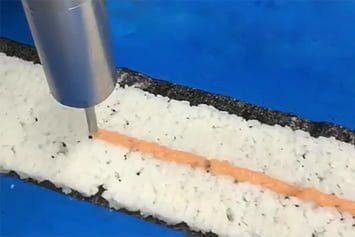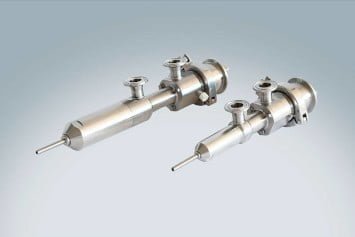Low in calories, rich in healthy fatty acids, vitamin B and minerals – no wonder sushi has been able to defend its reputation as a trend food for a long time. Cleanliness is an important requirement in the production of the popular rolls. In many variations, raw fish is being processed. However, manufacturers are faced with further challenges, especially when it comes to automated dosing of the various ingredients: Some pastes are highly viscous and cannot be dosed by simple time-pressure systems, for example. Others contain shear-sensitive fillers or are themselves particularly shear-sensitive and must not be squeezed. In addition, flexible switching between different ingredients is often required on a production line. For good results, a pulsation-free, continuous product flow on the production line is required. The choice of the right equipment is absolutely crucial for success in this area.
Gentle processing of the individual ingredients
In an application example of the dosing technology specialist ViscoTec, various ingredients are continuously dosed onto a belt onto which runs an endless web of Nori leaves with rice. For example, salmon with mayonnaise, wasabi, chili sauce or artificial caviar is applied. Wasabi is a highly viscous paste that can be perfectly dosed with ViscoTec’s viscosity-independent dosing systems, which are designed based upon the endless piston principle. The artificial caviar is particularly shear-sensitive – the eggs must not be crushed or ground during the dosing process under any circumstances. The principle built into the ViscoTec pumps is therefore also ideally suited for these ingredients. The solids in their carrier medium are displaced particularly gently through the chambers between the rotor (stainless steel) and stator (elastomer). Form, color and consistency of the solids is not affected.
The amount of material to be applied can be perfectly adjusted to the belt speed by means of a control system. The individual ingredients are dosed continuously and absolutely pulsation-free. An uneven dosing would mean, for example in one roll only half the amount of wasabi, and in another roll double the amount. This would have a negative influence on the taste experience. Anyone who has ever had a little too much of something spicy knows this.
Flexible production
For a product change during production, the VHD Hygienic Dispensers from ViscoTec have a hygienic design which allows for two possibilities: Either a simple disassembly and cleaning can be carried out between product changes or the old material is pushed out with the new material. Since the dispenser is optimized for dead space, this second option can also be easily implemented when changing over. After a short mixing phase, production can continue without having to clean the machine.
Excellent pressure stability
The ViscoTec Hygienic Dispensers are designed according to the EHEDG guidelines. They are easy to disassemble and clean and can also be sterilized or autoclaved. Different dosing needle inserts and dosing speeds allow maximum flexibility in the production process. It is possible to dose very small quantities of the spicy wasabi paste into a sushi roll, but also relatively large quantities as required for example for salmon with mayonnaise. The thin needle during application of the highly viscous Wasabi paste generates a high back pressure – a challenge for the dosing system. The ViscoTec dispensers are predestined for this application due to their excellent pressure stability even at back pressures above 12 bar. The sealed cavities, which span the rotor-stator geometry during filling, allow the dispenser to run against pressure. Due to the overlap at the edge, about 5-6 bar per cavity can be overcome. With several cavities in a row, for example with the 3-stage dosing pump 3VHD12, up to 18 bar back pressure is no problem.
The material is supplied to the dispenser via cartridges with a size of up to 900 ml or directly from a delivery container (i.e. 25 liter bucket) via the ViscoMT-XS emptying system. Overall, the endless piston principle offers a high degree of automation for safe, uninterrupted production.



